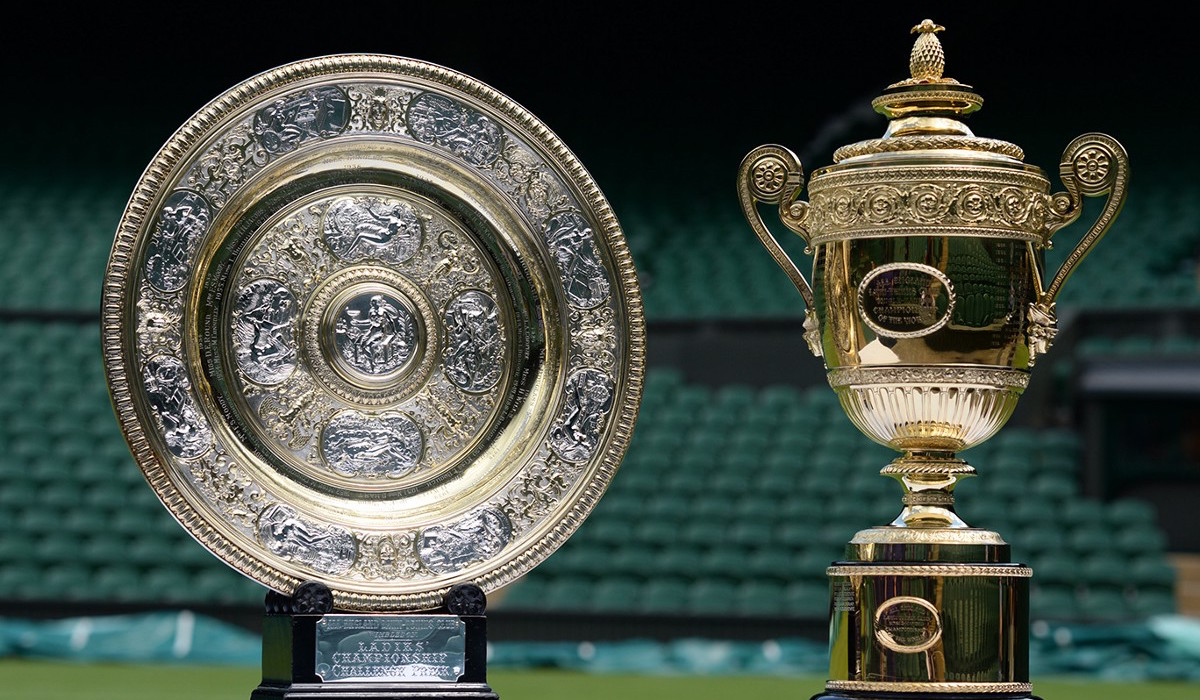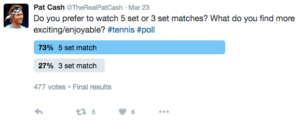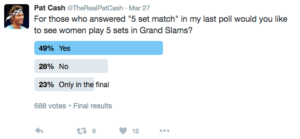
Photo credit: Wimbledon
To be honest I’ve been hesitant to touch this controversial issue. In today’s politically correct climate and social media fueled outrage culture there seems to be some topics that simply cannot be discussed without immediately being called a sexist or worse. Shutting down conversations by resorting to name calling rather than engaging with the idea in an intellectually honest way has unfortunately become commonplace online. The reputational cost of being smeared simply for sharing my thoughts and the resulting headache in having to deal with the fallout is one the reason I almost didn’t write this post. However, problems don’t go away if we don’t talk about them. And the controversy and problems surrounding the gender equality and equal prize money debate in tennis will not go away until we can have an open and honest conversation about it. That’s what I’m trying to do here. Let’s hope I don’t regret it.
So without further ado I’m going to try and break this down and give you my opinion. But before I jump into the equal prize money debate I feel we need to define what equality means.
Defining Equality.
For a term that’s talked about so much, we seldom come across a clear definition of what equality and gender equality actually means. Not defining words correctly is a fast way to end up with misunderstandings and heated debates that go nowhere.
Let’s start with a definition of equality from the Oxford Dictionary:
“The state of being equal, especially in status, rights, or opportunities.”
A good definition a bit vague. Let’s narrow our focus further with a definition of gender equality from the Cambridge Dictionary:
“The act of treating women and men equally: Gender equality does not imply that women and men are the same, but that they have equal value and should be accorded equal treatment.”
Together these definitions do a pretty good job defining what equality and gender equality are. For the purpose of this post I’m going to clarify this even further by breaking it down into three main points.
- All people have the same intrinsic value. Hopefully this is obvious to everyone. Whatever your sexual orientation, religion, race, sex, ethnicity, etc., all humans have the same value.
- Everyone deserves equal opportunities. Everyone has the right to be treated without discrimination based on their sex, race, etc. For example, who gets a job should be determined by competence and individual merit not sex or skin colour.
- Equality does not mean we have to become the same. We are all different and that’s okay. Equality means we’re all valued equally and receive equal opportunities despite our differences. Everyone deserves the freedom to choose a path in life that is right for them.
Phew, now that we’re all on the same page let’s move on to the controversy surrounding equal prize money in tennis.
About The Grand Slams.
The debate surrounding equal pay in tennis has raged on for decades and the topic is as complicated as it is polarizing. This post will not be a comprehensive analysis of the entire issue. Rather I am going to touch on and attempt to clarify certain points that seem to have people confused. Like why do women play best-of-3 sets and men play best-of-5 five sets in Grand Slam matches?
So, in case you don’t know, at the Grand Slams men play best-of-5 set matches and women play best-of-3 set matches. During the rest of the tour calendar both the men’s and women’s tour play best-of-3 set matches.
Let’s talk about the Grand Slams. The holy grails of tennis…
On the men’s side, one of the reasons winning a Grand Slam is considered the pinnacle of tennis achievement is because of best-of-5 set matches. This format is the best way to ensure the best player takes home the trophy. You consistently have to be the best player over the course of the whole event. In other words you have to be the toughest and fittest player both physically and mentally to win. The five set format not only distinguishes Grand Slams from regular tour tournaments, it also enables great rivalries to further flourish and develop. A by-product of this is some of the most epic, emotional and entertaining moments in sports. This in turn is why the prize money at Wimbledon, Roland Garros, etc., is so high.
This isn’t to say that women’s matches at Grand Slams aren’t epic, emotional and entertaining or that the women’s tour lacks great rivalries. Just look to Monica Seles vs. Steffi Graf, Venus Williams vs Lindsay Davenport or the amazing rivalry between Chris Evert and Martina Navratilova. However, imagine if these matches and rivalries had been played out over five sets. Who wouldn’t want to see that?! I know I would!
Recently I conducted a highly scientific and rigorous piece of research…. I polled my Twitter followers.

As you can see from the above screenshot, most people prefer best-of-five set matches. Next I asked the following question:

Again 5 set matches proved to be the most popular.
Why don’t women play five set matches at Grand Slams?
This is a good question and I think the reason is mostly rooted in the old outdated mindset that women are too delicate and don’t have the stamina to go five sets. If you don’t think Martina Navratilova, Steffi Graf or Serena Williams could handle five sets you are a fool.
The notion that women can’t play five sets is ridiculous and quite frankly condescending. My friends on the WTA tour would relish the opportunity to compete over five sets like Billie Jean King at the Battle of the Sexes. Or the legendary 1990 WTA Tour Finals where Monica Seles won in 5 after coming back from a 2-1 deficit. A title she would have lost under best-of-3 sets.
As you can see there is some historical precedent. In fact the top players and the WTA itself have frequently asked to play best-of-five in the Grand Slams. Stacey Allaster, previously the head of the WTA, said her women are ‘ready, willing and able’ to play five sets. She’s said this on multiple occasions. So has Navratilova, the Williams sisters and many more.
Yes it is more physically and mentally challenging to play for longer. Just like it’s tougher to run 5 miles rather than 3. It’s easier and more comfortable to not go the extra mile and to stay complacent sticking with the status quo. And I’m sure some will want to do that. But it’s this extra challenge that makes best-of-five so exciting. It forces players to bring their absolute best, pushes them to their limits and elevates the game as a whole. This is something all great competitors and fans want.
The sad truth is that women don’t play best of five sets partly for reasons rooted in old fashioned sexism of low expectations. Yes there would be scheduling challenges and a myriad of other logistical issues to consider. But just because it is inconvenient doesn’t mean women shouldn’t have the same opportunity men have to play full best-of-5 set matches at the Grand Slams if they want.
Should men play best of three set matches at Grand Slams?
Why should they? Best of five set matches has always been how the game has been played at Grand Slams. For reasons I’ve mentioned above, I believe changing this would be a mistake. It would fundamentally change the game for the worse. Players would lose the opportunity to reach their full potential and viewers would forever miss out on epic showdowns like the 2008 Wimbledon Men’s Final (considered by many to be the greatest match ever). It would hurt the game of tennis as a whole and nobody want’s this. I’ve yet to see any proof of how this would benefit anyone or why it would be a good idea.
Equal prize money at the Grand Slams.
So do men and women win the same amount of money at Grand Slams?
Yes they do.
Does this mean there is gender equality, in particular equal pay in tennis?
No not quite unfortunately.
I know, I know it’s confusing. But I’ll try to explain…
Imagine you and another person had the same exact same position in a company. Except that you worked 40% more – longer hours, overtime, out of office work, etc. In this situation would it be fair if you both got paid the exact same amount? Does your colleague deserve equal pay for doing less work?
Doesn’t seem right does it.
At the Grand Slam events a men’s singles match can go on for 40% longer than their fellow women competitors. Obviously this percentage varies from match to match but over the course of an event this adds up to a lot more work. And this is not counting the extra physical and mental training required to prepare for and recover from such occasions. Now I’m not saying female players don’t compete and train as hard as male players do. I’m just saying they don’t have to do as much of it (they don’t have to incorporate the additional training required to prepare for 5 set matches).
Now I’m not advocating that players should be paid exclusively based on match time. That would just be silly. What I’m getting at is that there needs to be a level playing field. The framework we operate within needs to be the same for all players so that everyone has equal and fair opportunities. In most popular sports the game (rules, distance, field size, etc.) isn’t substantially different between the sexes. Female athletes don’t run 60 metres at the 100 metre sprint at the olympics. Why should this be the case for women’s tennis?
“It’s not about the money. It’s about the equality message”.
I absolutely agree with her. Equality means women and men should be accorded equal treatment. At joint events like the Grand Slams this means the rules, scoring and prize money should all be the same (in other words equal). To believe otherwise is hypocritical in my eyes.
What is the solution?
Well I see two logical and fair solutions to the equal pay/prize money issue at the Grand Slams:
Scenario 1: Women and men both play best-of-5 sets in Grand Slams. Everyone gets equal prize money.
Scenario 2: Men play 5 set and women play 3 set in Grand Slams. Men get more prize money.
As many may have guessed by now I believe scenario 1 to be the best option. Aside from some logistical issues I don’t see a downside here. In this scenario men and women are valued equally and earn equal prize money for playing equal amounts of tennis.
Please keep in mind that I’m not discussing the economic issues like market value, TV licences, ticket prices/sales, etc. This post is already too long for that!
Conclusion.
The fight for equal prize money at the Grand Slams has been long and hard but tennis has become better as a whole for it. However, things are still not quite equal. Yes we’re closer but we still have a little way to go. At the moment the system is biased against male players and favorable towards women’s Grand Slam players.
Yes overall things are much better than they were. However, the scales seem to have tipped too far in the other direction to be considered equal or fair. But where are the voices who have been so vocal for women’s equality now that the shoe is on the other foot? In this politically correct world it’s important that they keep speaking up because many men on the tour are afraid to speak up for fear of being unfairly branded sexist. Again, this is not about the money (which is good enough to go around) it’s about the principle of equality.
Until we can talk openly about all aspects of the equal pay issue, it will continue to rear its head. The sport has already come so far in terms of gender equality so there’s no reason that decision makers and players can’t come together to make these changes happen. There’s no way to make absolutely everyone happy but I think what I’ve suggested can be easily supported by both sides.
Lets at least start with best-of-5 sets for the women’s final. Logistically speaking this is easy to schedule and it’s something just about everyone wants to see.
This is a great opportunity and we shouldn’t let it pass without having some serious discussions. What do you think…?
If you enjoyed this post please sign up for my newsletter. It’s where I share member exclusive content not found anywhere else. Including interviews, my favourite gear, health & fitness exercises, tennis tips and more. Sign up here.



